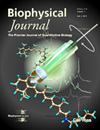Time-dependent active force drives periodic reversal in collective cell migration.
IF 3.1
3区 生物学
Q2 BIOPHYSICS
引用次数: 0
Abstract
Collective cell migration is prevalent in the processes of embryo development, wound healing, and cancer metastasis across various space and time scales. While various motion modes have been identified, their relationships with single cell motility and the underlying mechanisms remain poorly understood. In this study, we develop an active vertex model to investigate the spatiotemporal behavior of collective cells confined in annulus domain, accounting for the polarity memory effect of individual cells and the impact of confinement size. We reveal that cells spontaneously undergo periodic reversals in the rotation direction, with the inner boundary acting as the origin of initiation. The polarity delay with velocity and the growth of passive forces contribute to the reversals. The reversal frequency increases with the memory decay rate while remaining largely insensitive to the activity strength. In addition, we propose a polar order parameter to characterize various motion modes across a wide range of parameter spaces. This parameter effectively identifies four distinct dynamic regimes: global rotation (GR), periodic reversal (REV), oscillation (OSC), and local swirling (LS). Our findings establish a framework for understanding the persistence of collective cell migration under geometric confinements and underscore the timescale required for molecular rearrangements during polarization.时变动力驱动集体细胞迁移的周期性逆转。
细胞集体迁移在胚胎发育、伤口愈合和癌症转移过程中普遍存在,跨越了不同的时空尺度。虽然已经确定了各种运动模式,但它们与单细胞运动的关系及其潜在机制仍然知之甚少。在这项研究中,我们建立了一个主动顶点模型来研究被限制在环域中的集体细胞的时空行为,考虑了单个细胞的极性记忆效应和限制尺寸的影响。我们发现细胞自发地在旋转方向上进行周期性的反转,内部边界作为起始的起源。极性随速度的延迟和被动力的增长是导致地磁倒转的原因。反转频率随记忆衰减率的增加而增加,而对活动强度基本不敏感。此外,我们提出了一个极序参数来表征各种运动模式在广泛的参数空间。该参数有效地识别了四种不同的动态机制:全局旋转(GR)、周期反转(REV)、振荡(OSC)和局部旋转(LS)。我们的发现为理解几何限制下集体细胞迁移的持久性建立了一个框架,并强调了极化过程中分子重排所需的时间尺度。
本文章由计算机程序翻译,如有差异,请以英文原文为准。
求助全文
约1分钟内获得全文
求助全文
来源期刊

Biophysical journal
生物-生物物理
CiteScore
6.10
自引率
5.90%
发文量
3090
审稿时长
2 months
期刊介绍:
BJ publishes original articles, letters, and perspectives on important problems in modern biophysics. The papers should be written so as to be of interest to a broad community of biophysicists. BJ welcomes experimental studies that employ quantitative physical approaches for the study of biological systems, including or spanning scales from molecule to whole organism. Experimental studies of a purely descriptive or phenomenological nature, with no theoretical or mechanistic underpinning, are not appropriate for publication in BJ. Theoretical studies should offer new insights into the understanding ofexperimental results or suggest new experimentally testable hypotheses. Articles reporting significant methodological or technological advances, which have potential to open new areas of biophysical investigation, are also suitable for publication in BJ. Papers describing improvements in accuracy or speed of existing methods or extra detail within methods described previously are not suitable for BJ.
 求助内容:
求助内容: 应助结果提醒方式:
应助结果提醒方式:


